Referring
These slides are available for use with this section of the presentation. For information about downloading presentation slides, see Introduction.
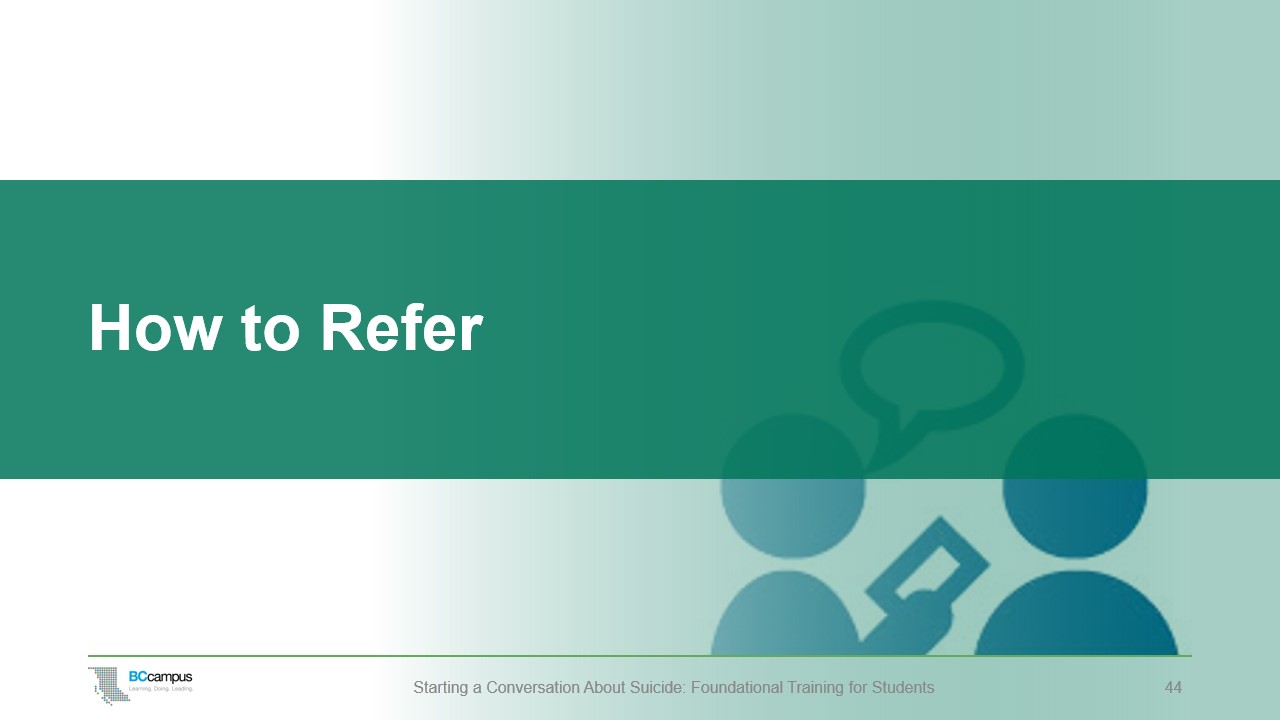
Asking About Supports and Suggesting Resources
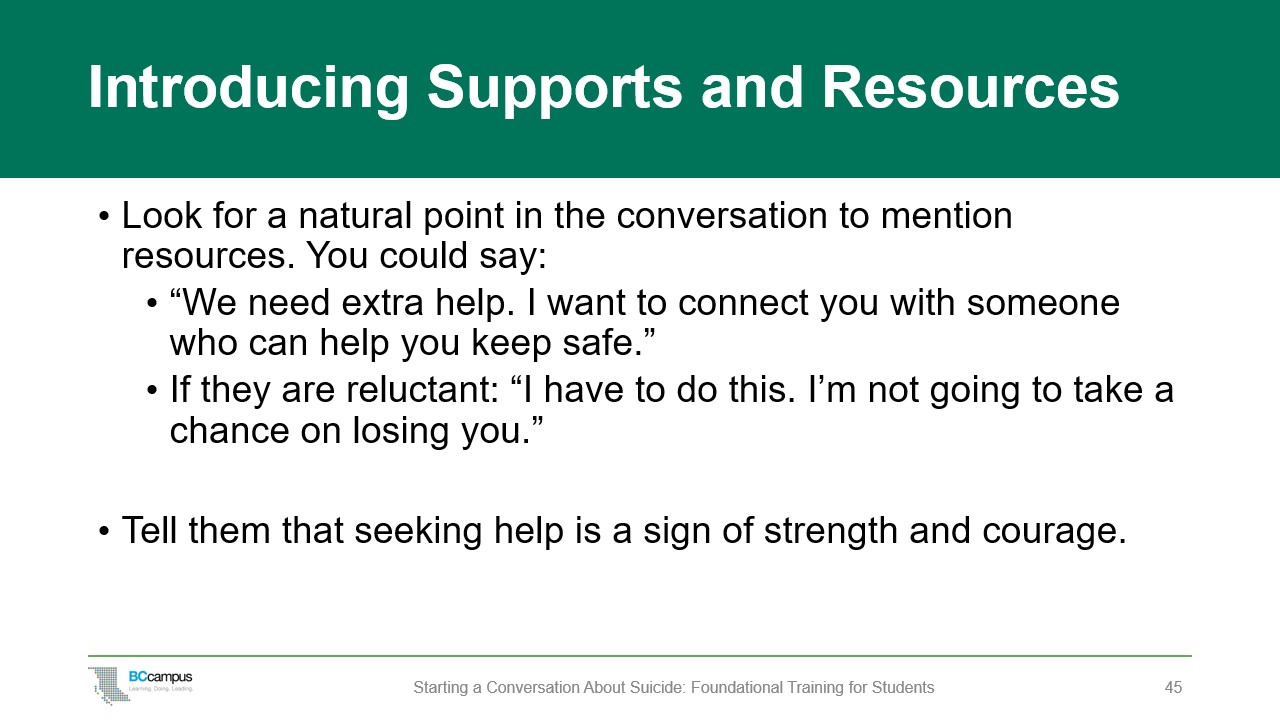
When talking to a person in distress, look for a natural point in the conversation to ask about their supports and mention resources. First, ask the person about their supports: “Do you have other people you can talk to? Have you talked to anyone else?” You may not be the first person the student has reached out to for help, and this may not be the first time they have thought about suicide. Asking “Have you talked to others about this?” or “Have you reached out before?” can be a natural bridge to talking about supports and referrals.
To introduce the idea of a referral, you could say, “We need extra help. I want to connect you with someone who can help you keep safe.”
If they are reluctant, you could say, “I have to do this. I’m not going to take a chance on losing you.”
Point out that seeking help is a sign of strength and courage.
Campus Resources and Provincial Crisis Lines
Ask participants how familiar they are with campus and community resources. You could ask them to share what they know and then focus the discussion on the needs of the particular group. If some people are very knowledgeable, they can share their ideas so it becomes a more interactive part of the session. Then share the next slide to review resources found at most campuses.
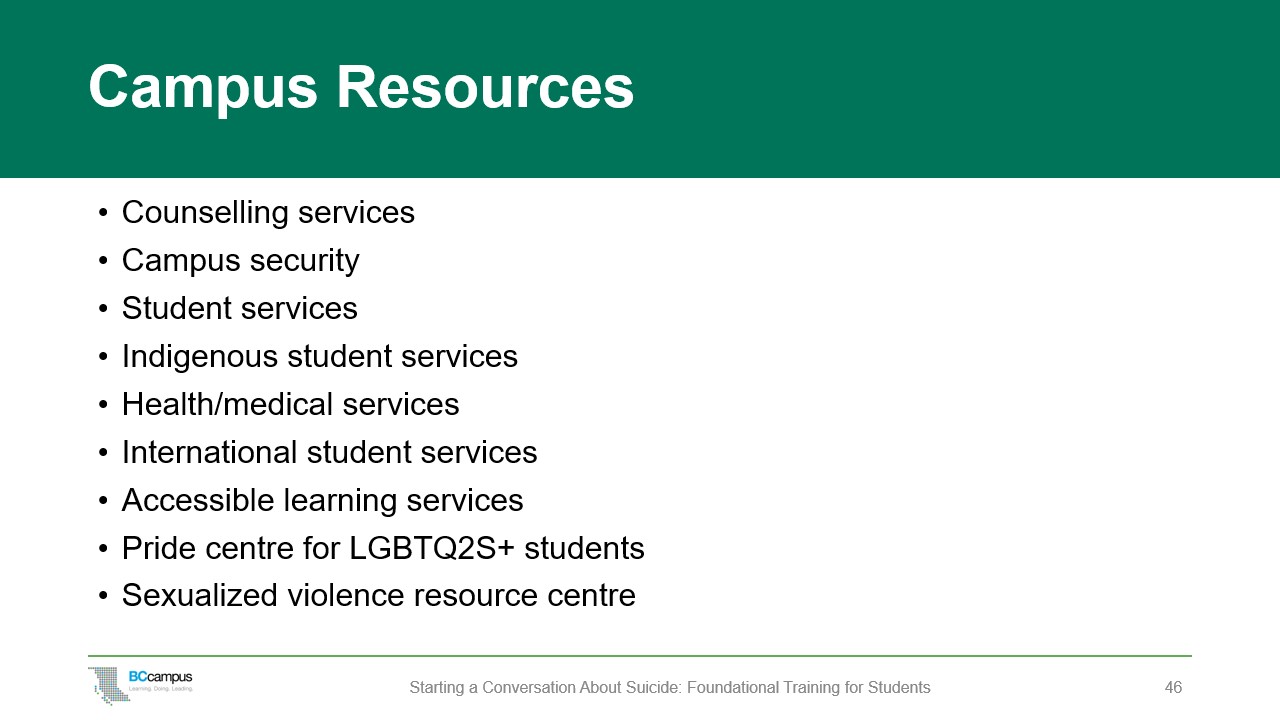
If it is not an emergency situation, you can refer the person to supports on campus. This could mean just sharing a website or phone number or it could mean walking with the person to counselling services to ensure that they connect with a counsellor; it will depend on the situation and your relationship with the person.
There may be a list with services and contact information for these services at your institution. If not, Handout 1: Quick Reference: Responding to Students in Crisis is a fillable PDF that has space to add in contact information for key supports. Here are some of the services that are available at most campuses:
- Counselling services help students manage personal, academic, and life concerns. Professional counsellors provide individual and group counselling sessions for students.
- Campus security helps coordinate responses to student emergencies and crises. If you call 911, also call campus security, as security can help first responders locate you.
- Student services offer many supports for students.
- Indigenous student centres offer support, mentorship programs, and a gathering place. Many campuses have an Elder who may be available to talk to students.
- Health or medical services offer health and mental health care for students.
- International student services help students with personal or academic issues, study and work permits, and visa applications.
- Accessible learning services provide services and coordinate academic accommodations for students.
- Pride centres provide support to LGBTQ2S+ students.
- Sexualized violence resource centres offer support for victims of sexualized violence.
If not on campus, these services can connect with students by telephone or video.
Facilitator Note: Support for Marginalized Groups
When a person has a sense of belonging and connectedness with family, friends, culture, and community, they are less likely to take their own life. Unfortunately, not all students have this sense of belonging, and some students, such as Indigenous students, international students, students with disabilities, and students who are LGBTQ2S+, are at a higher risk of isolation and may not have the support they need.
Here are some services that most campuses have for students:
- Indigenous students – Most campuses have an Indigenous student centre. A staff member or Elder can make themselves available to talk to a student needing support.
- For international students, international student services on your campus can be a great resource.
- You could connect students with disabilities with student services or the accessible learning centre.
- You could refer students who are LGBTQ2S+ to student services, the pride centre, or an LGBTQ2S+ organization in your community.
Provincial Crisis and Support Lines

Some larger campuses have a crisis line for students. If your institution does not have this service, there are also provincial crisis and suicide lines that offer 24/7 support. These crisis lines also provide support to anyone who is helping a student in distress and needs to talk to someone and debrief.
There are a number of provincial crisis lines that offer support. Here are some key ones:
- B.C. Suicide Line: 1-800-784-2433 (1-800-SUICIDE) or https://crisiscentre.bc.ca/
- Mental Health Support Line: 310-6789 (no need for area code)
- Here2Talk: 1-877-857-3397 (24-hour phone and chat counselling support service for B.C. post-secondary students) Note: If you request support in a language other than English or French, Here2Talk may be able to match a student with a counsellor who can support a student in their own language (https://here2talk.ca)
- KUU-US Crisis Line: 1-800-588-8717 (1-800-KUU-US17) – provides culturally safe support, 24/7, for Indigenous people in B.C. (www.kuu-uscrisisline.com/24-hour-crisis-line)
If you haven’t already shared Handout 1: Quick Reference: Responding to Students in Crisis, do it now so participants have a sheet with referral information.
If You’re Concerned for a Person’s Immediate Safety
If It’s an Emergency
If it’s an emergency situation, such as when a person has taken pills, is experiencing psychosis, or is a danger to themselves, call 911 (also contact campus security if you are on campus). If you are not at risk, do not leave them alone until help arrives.
If the person is agitated, threatening, or aggressive, call 911 while making sure you and others are safe.
If It’s Not an Emergency But You’re Concerned
If it’s not an emergency, but you are concerned, offer to contact support services on the person’s behalf while they are with you. You may also offer to walk with them to counselling services. If you’re not on campus, offer to call the suicide crisis lines listed above to get advice.
If You Are Unsure What To Do
If you are unsure what to do, you can contact campus security, which is always available for students on campus. You can also contact student services or counselling services at your campus. Counsellors can talk with anyone who is concerned about a student and is unsure how to handle the situation. You can also call one of the provincial crisis lines if you have concerns about someone you know. You are encouraged to consult when:
- You are concerned about a student’s safety or well-being but are unsure how or whether to intervene.
- You are uncertain how to respond to someone who needs help.
- You continue to be concerned about someone you know who has declined help.
If a Student Won’t See a Counsellor or Seek Help
Sometimes a student won’t want any help.
Your first step will be to consider safety: Is anyone at risk of immediate harm, whether it’s the student or someone else? If so, share your concerns with a counsellor or someone who can help ensure safety. If a student expresses thoughts about suicide, you don’t have to carry that knowledge alone or assess the risk yourself – consult, refer, and, if the risk is imminent, contact emergency services.
If there is no risk of harm to anyone, keep in mind that ultimately it is the person’s right to choose whether to seek help. People are resilient and often come to their own solutions or find their own supports when they are ready.
Ensure that you are supported! Talk to friends, family, instructors, an Elder, or a counsellor to share your concerns and decide how to proceed.
What About Social Media?
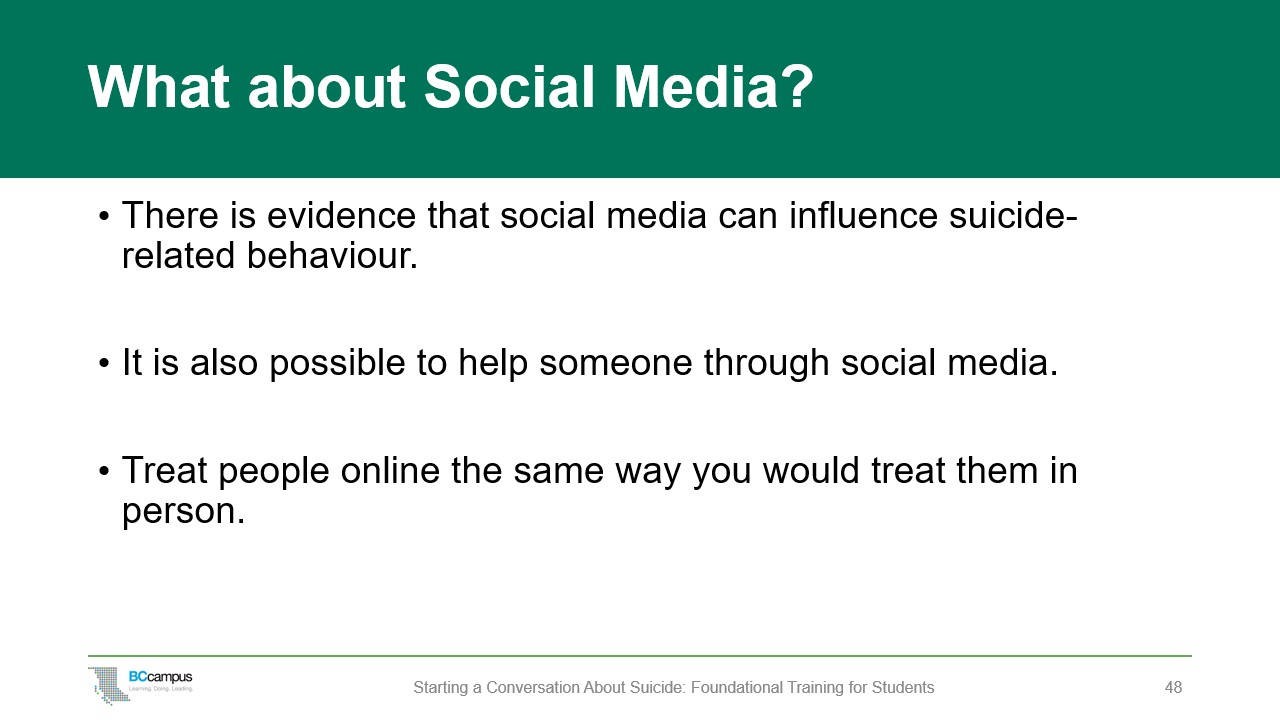
There is increasing evidence that the Internet and social media can influence suicide-related behaviour. Research has shown a connection between cyberbullying and suicide. Social media has also been shown to lead to insecurity, body-image problems, and emotional distress. And there has been a proliferation of pro-suicidal sites, message boards, chat rooms, and forums in recent years.
It is also possible to help someone through social media. If someone you know says anything on social media that makes you think they may be suicidal, take it seriously. Treat people online the same way you would treat them in person.
Keep the channels of communication open; get more information about the person, such as name and contact details (location and phone number). Find out from the person if they have a suicide plan and try to get the details of the plan.
Encourage the person to contact a crisis line or family and friends who can provide immediate and personal help.
Direct the person at risk to a local suicide crisis line or mental health help line.
If the person is in imminent danger, call 911 and give whatever information you have.

Summary: What to Keep in Mind When Talking About Suicide
When having a conversation about suicide, keep the following in mind:
- Ask directly about suicide. Stay calm and listen.
- Acknowledge how the person is feeling and let them know you want to help.
- Ask about personal supports. Do they have other people they can talk to? Have they talked to anyone else?
- Provide information about resources. Connect them with supports or professional help.
- If something still doesn’t feel right, consult with your student centre, supervisor, campus security, or campus resources.
Scenario Walk-Through
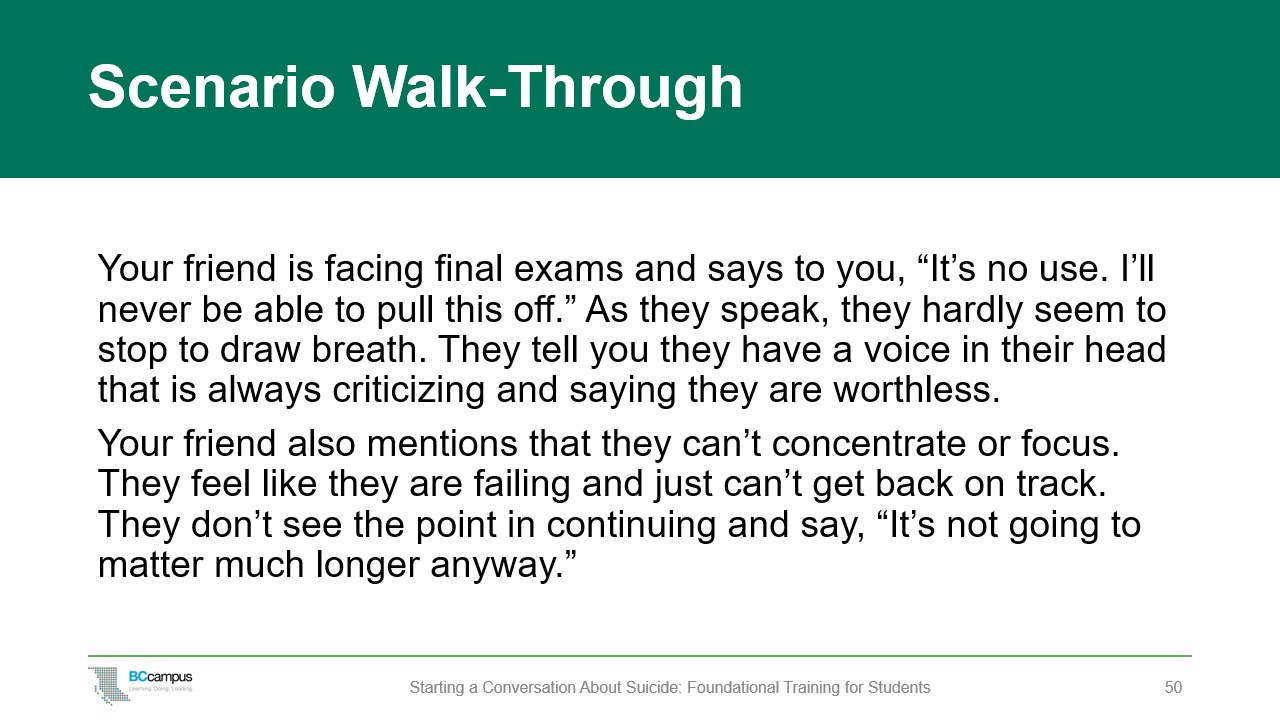
To help participants think about how they would talk to a friend that they’re concerned about, you could read this scenario out to them and then have a discussion about the best way to respond to their friend.
Scenario
A friend is facing final exams and says to you, “It’s no use. I’ll never be able to pull this off.” As they speak, they hardly seem to stop to draw breath. They tell you they have a voice in their head that is always criticizing and saying they are worthless.
They also mention that they can’t concentrate or focus. They feel like they are failing and just can’t get back on track. They don’t see the point in continuing and say, “It’s not going to matter much longer anyway.”
How would you respond?
Key points include:
- Highlight support and empathy while recognizing the capacity of the other student.
- Ask about suicide.
- Suggest a referral or follow-up.
A possible response could be:
- Start with an empathetic response: “I can see that you’re upset about the exam. I can hear the disappointment in your voice and understand your fear about what will happen for you.”
- Ask directly about suicide: “I may be way off base, but when you say you say, ‘It’s not going to matter much longer anyway,’ do you mean that you are thinking about suicide? I want to support you to be safe and to have a good outcome from this challenging time.”
- Suggest a referral: “I wonder if you’d be willing to talk to a counsellor? It’s confidential and I think it’s a wise thing to do. I’d like to walk over there with you.”
If the person refuses, you could say, “Another option is for us to call the crisis line together right now so you can talk with them and find out about some resources.”
If they say no, you could say, “I care about you and am worried about you, so for me to feel comfortable, I need to have someone contact you to see how you’re doing and help support you.”
What Helps People Recover?
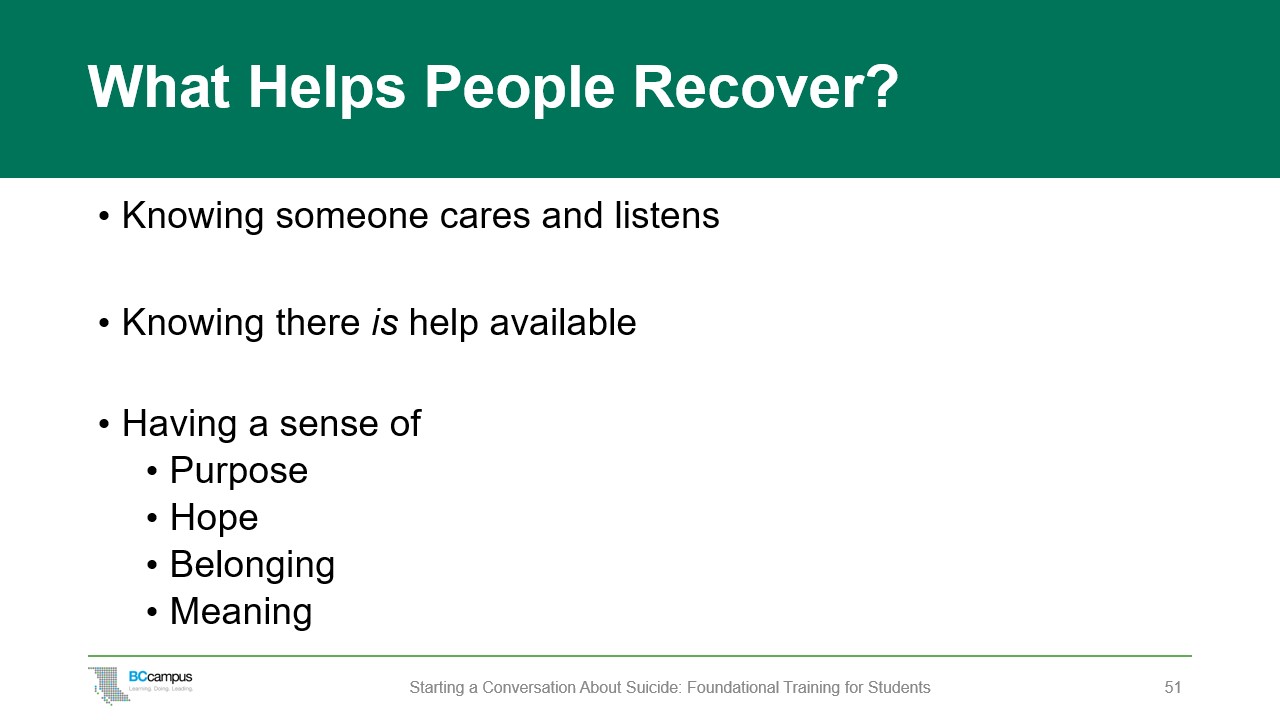
Remember: The most important thing you can do is listen and help connect the person with resources. Knowing that someone cares and that there is help available is what helps people recover. Having a sense of purpose, hope, belonging, and meaning is essential to recovery.
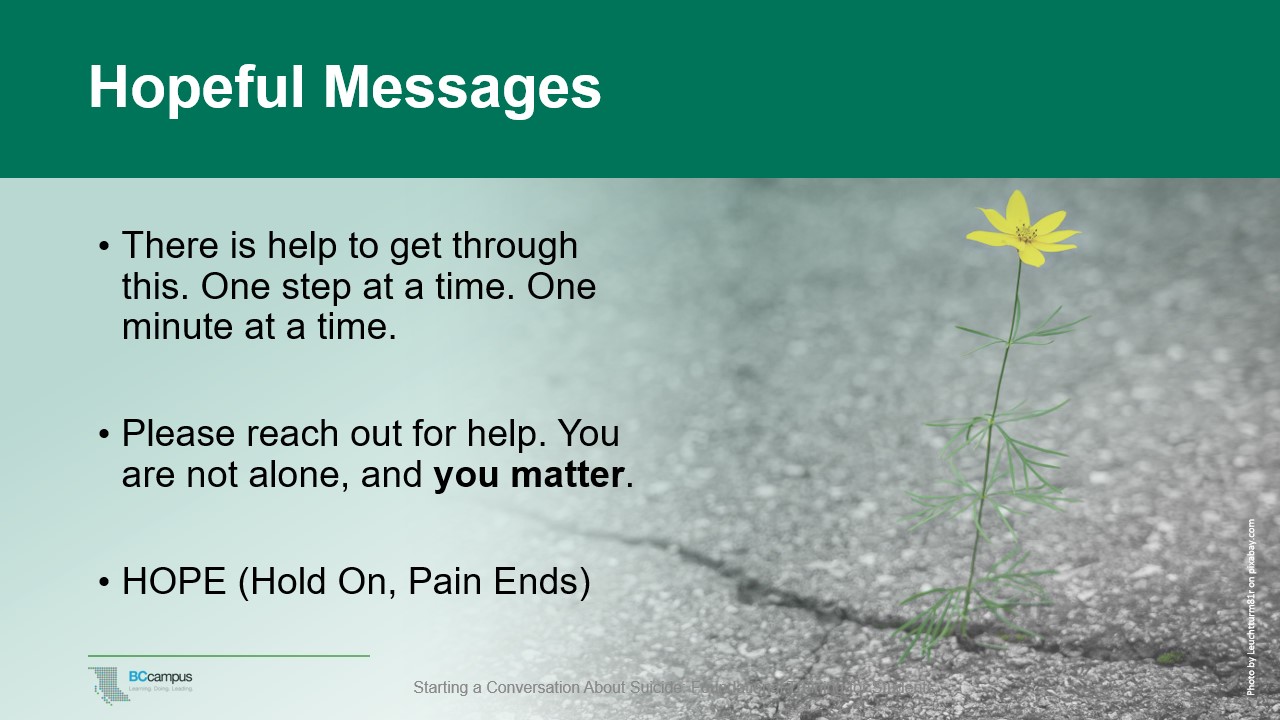
People who are considering suicide have lost hope, and they need to be reminded that there is hope. Hopeful messages for people who have thoughts of suicide include:
- There is help to get through this. One step at a time. One minute at a time.
- Please reach out for help. You are not alone and you matter.
- HOPE (Hold On, Pain Ends).
When you are supporting someone, remember:
- Be patient. Be hopeful.
- Always take the person seriously, even if they have expressed thoughts about suicide in the past.
- Listen, and ask them what they need to be safe.
Break
This is a good point in the session to give participants a five-minute break to get up, stretch, and reflect on what they’ve learned so far. This could also be a good time to walk participants through the breathing exercise below.
Activity: Box Breathing
Before the break, you could invite the group to engage in a box breathing exercise to give everyone a few moments to focus on their own emotional well-being and to practise a stress management technique.
Box breathing is a very simple stress management exercise that can be practised anywhere. Encourage participants to try box breathing if they start to feel overwhelmed at any point. Below are instructions for leading a group through box breathing.
If possible, sit and close your eyes. If not, just focus on your breathing.
- Step 1: Inhale (preferably through your nose) for a count of 4.
- Step 2: Hold your breath for a count of 4. You’re not trying to deprive yourself of air; you’re just giving the air a few seconds to fill your lungs.
- Step 3: Exhale slowly through your mouth for a count of 4.
- Step 4: Pause for a count of 4 (without speaking) before breathing again.
Repeat this process as many times as you can. Even 30 seconds of deep breathing will help you feel more relaxed and in control.
Media Attributions
- Referral Icon No Attribution by Ahkâm is licensed under CC0 Public Domain.
- Flower Road Crack by Leuchtturn81 is licensed under a Pixabay License.

